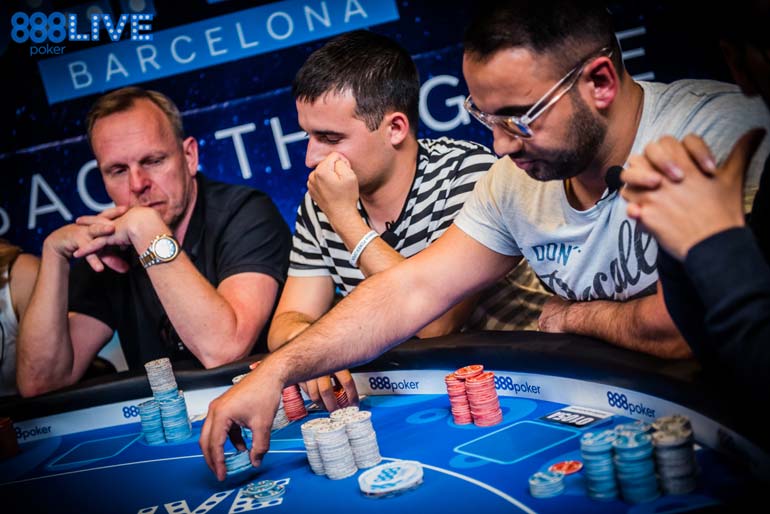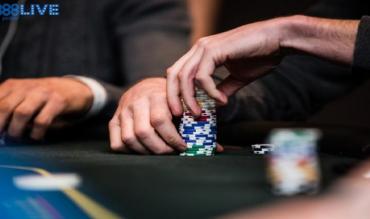Professional players know that carefully selecting bet sizes is one of the best ways to boost win rate in poker.
By controlling the size or our betting, we allow ourselves the opportunity to gain the upper hand on our opponents – and win more frequently.
Here we’ll discuss bet-sizing in tournament poker and consider some of the unique bet-sizing opportunities that this format presents.
Table of Contents
General Sizing vs Cash Games
A natural starting point might be to make a comparison of bet sizings in poker tournaments vs bet sizings in cash games.
The following general rule applies -
Bet sizings in tournaments are typically smaller than bet sizings in cash games.
A key reason for this is the reduced average effective stack size in tournaments compared to cash games. Sure, we might start with 75-100bb, but any tournament player knows that we quickly find ourselves in the 10-30bb region unless we are running good.
Having fewer chips to work with typically means we want to make the most of the chips we have. We want to be able to exercise options like cbetting the flop or turn without committing ourselves to the pot.
Our opponents are also conscious of the smaller effective stacks and may not be willing to invest any additional chips into particular pots - even if the bet is tiny.
A technical way of expressing this might be as follows:
Our opponent’s continuing range potentially becomes inelastic for bet sizings below a certain threshold.
Although smaller sizings on average might be incentivised, we don’t want to make the mistake of thinking that larger betsizings are always incorrect. When we connect well with the deck, we usually want to put ourselves in a scenario where we can play for stacks.
We should not close ourselves off to the idea of betting large or even over betting if the situation calls for it.
Utilising Bubble Pressure

By the time we reach the tournament bubble, usually, antes are in play. Therefore, we cangenerate an excellent price on a steal, relative to cash games (the majority of which do not involve antes). This strategy is especially the case if our understanding of ICM (independent chip modelling) is on point.
Consider the following setup -
6-handed (on the bubble)
Blinds: 0.5bb / 1bb
Antes: 0.15bb
UTG – 8bb
MP – 25bb
CO –30bb
Hero – 40bb
SB – 18bb
BB – 11bb
At the start of the hand, we have 2.4bb worth of dead money in the pot. (In a standard cash game without antes there would be 1.5bb only in the middle). Now ordinarily, we might look to increase the size of any open-raise,given the extra dead money in the middle. (If we don’t, it’s going to be much harder to get a steal through).
But we are on the bubble, and there is an interesting dynamic at work. Let’s see what happens.
Everyone folds to Hero on the BTN
Hero openraises to 2bb
SB folds
BB folds
So, what allowed Hero to get away with such a cheap steal price despite the antes?
The key to understanding this situation is the realisation that we are on the bubble. The mid-stacks would prefer that the short-stacks busts before they take any significant risk.
In this example, UTG is the next in line to bust. SB and BB are following closely behind. Rather than go for the double up now and risk busting out, it’s much more valuable for the SB/BB to let UTG bust and get the stacks in afterwards. Let’s think about it from both the SB and BB’s perspective when facing our open.
SB – Although the price is low, the SB doesn’t want to call, and risk being shoved on by the BB. Although SB has the BB covered, he runs the risk of becoming the new short-stack at the table. It’s also unwise for SB to tangle with a stack that has him covered (i.e. us). In bubble scenarios, it’s usually better to battle it out with players who can’t do any significant damage to the health of our stack.
BB –The situation is forcing the BB to play tight here. He doesn’t want to risk catching some piece of the flop, getting committed and then being knocked out on the bubble. ICM pressure is forcing both the BB and SB to play very tight ranges. UTG will be heading into the BB on the next hand, further decreasing his stack.
Being aware of this dynamic helped us to generate a cheaper than usual preflop steal.
All-in / Fold
Another scenario unique to tournaments is the “push/fold” stage. As stack sizes get depleted, it stops being correct to open-raise for a regular sizing. We should either be folding or jamming all-in if we think our hand is strong enough.
The exact threshold might vary depending on the circumstances, but the following is a useful basic guide.
Once our stack reaches less than 12bb we should either be shoving all-in or folding preflop.
It’s essential not to be overly dogmatic about this since it’s entirely possible to contrive a scenario where we should be open raising for a standard sizing (or even open limping) despite the fact that the stacks are less than 12bb.
However, these scenarios are typically the exception rather than the rule.
Awareness of $EV
If we have strong cash game fundamentals, some tournament situations might confuse us at first glance.
Let’s see an example -
Example – chip-EV vs $EV
We have a value hand on the river. It’s a favourite if we bet and get called, but it will undeniably run into stronger holdings from time to time.There is 30bb in the middle, and we have 40bb in our remaining stack.
We have calculated that in terms of chip-EV that a bet sizing of 20bb and 40bb would yield an identical (chip-EV) expectation. Which sizing should we go with?
We have kept this example free from unnecessary mathematics. The crucial concept here is being able to understand the ICM implications of a 40bb vs a 20bb bet. Both may generate the same chip-EV (so in a cash game it wouldn’t matter), but they absolutely do not produce the same $EV.
So, what’s the difference between the two sizings here?
40bb – If we win, we make a few more chips in the short term. If we lose, our tournament is done.
20bb – If we win, our chip-EV is identical to the 40bb bet. If we lose, we still have a healthy stack remaining and the possibility of going on to win the tournament.
The simple explanation is that the 20bb bet is significantly stronger (in terms of $EV) because it preserves our tournament life.
This setup could easily be a blind spot if we are from a cash game background. Our initial calculations might lead us to believe that we are in different between the two sizings.
Consistently finding the correct bet-sizing will allow us to generate much higher $EV values even if the chip-EV ends up being identical (or even lower).
Click here to learn more about using ICM in Poker tournaments.
Click here to explore poker bet sizing in more depth.
Click here to see some push fold charts for tournament poker.


